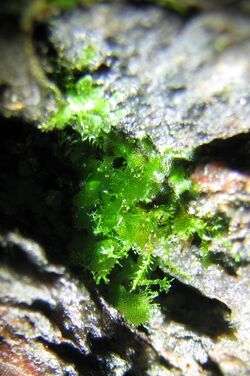Biology:Vittaria appalachiana
| Vittaria appalachiana | |
|---|---|

| |
| Scientific classification | |
| Kingdom: | Plantae |
| Clade: | Tracheophytes |
| Division: | Polypodiophyta |
| Class: | Polypodiopsida |
| Order: | Polypodiales |
| Family: | Pteridaceae |
| Genus: | Vittaria |
| Species: | V. appalachiana
|
| Binomial name | |
| Vittaria appalachiana Farrar & Mickel
| |
Vittaria appalachiana, or the Appalachian shoestring fern, is a fern species in the subfamily Vittarioideae of the family Pteridaceae. It is native to moist and shaded outcrops in the Appalachian Mountains. It is notable for existing only in the gametophyte stage of development, unlike other fern species in which the sporophyte stage predominates.[1] The species reproduces asexually through gemmae.[2]
The species was known to bryologists, who at first confused it with a liverwort. Aaron John Sharp brought the species to the attention of pteridologists Warren H. Wagner and Alma Gracey Stokey. It was formally named by Farrar & Mickel in 1991.[3]
Description
The sporophyte (normally the dominant generation of the fern life cycle) is almost never formed in this species. Tiny sporophytes have been found at one site in Ohio, and have twice been produced in culture. The few V. appalachiana sporophytes known have had rhizomes with clathrate (lattice-patterned) scales, and undivided, linear fronds less than 5 millimeters (0.2 in) long, features typical of vittarioid ferns except for their small size.[4]
Most populations of V. appalachiana are composed solely of gametophytes, which take the form of a thin green thallus, which is sparsely to extensively branched. The thallus bears filament-like structures called gemmae which project from its margin near the tips of the branches. The gemmae can fragment from the parent and grow into a new gametophyte. They vary in size from 2 to 12 body cells in length. Rhizoid primordia are present only on the two end cells of the gemmae, and are sometimes lacking from one or both. In general, gemma production is less uniform than in the gametophytes of other species of Vittaria.[4]
Habitat
Vittaria appalachiana grows in dense colonies in dark, moist crevices in non-calcareous rock. Habitats are usually dark and sheltered from extremes of temperature, and humidity; rock shelters and smaller cavities are favored. It occasionally appears as an epiphyte, growing on the bases of trees protected within narrow gorges. Populations have been found at altitudes from 150 to 1,800 meters (490 to 5,900 ft).[4]
References
- ↑ Farrar, Donald R.; Mickel, John T. (1991). "Vittaria appalachiana: A Name for the "Appalachian Gametophyte"". American Fern Journal 81 (3): 69–75. doi:10.2307/1547574. ISSN 0002-8444. https://www.jstor.org/stable/1547574.
- ↑ Pinson, Jerald B.; Schuettpelz, Eric (April 2016). "Unraveling the origin of the Appalachian gametophyte, Vittaria appalachiana". American Journal of Botany 103 (4): 668–676. doi:10.3732/ajb.1500522. PMID 27033317.
- ↑ Farrar, Donald R. (April 2016). "Vittaria appalachiana continues to provide insight into the biology of ferns: A commentary on two studies recently published in American Journal of Botany". American Journal of Botany 103 (4): 593–595. doi:10.3732/ajb.1500323. PMID 27056930. https://bsapubs.onlinelibrary.wiley.com/doi/abs/10.3732/ajb.1500323. Retrieved 13 December 2021.
- ↑ 4.0 4.1 4.2 Farrar, Donald R. (1993). "Vittaria appalachiana". in Flora of North America Editorial Committee. Flora of North America North of Mexico. 2: Pteridophytes and Gymnosperms. New York and Oxford: Oxford University Press. http://www.efloras.org/florataxon.aspx?flora_id=1&taxon_id=233501343. Retrieved 7 February 2022.
Wikidata ☰ Q17117517 entry
 |

